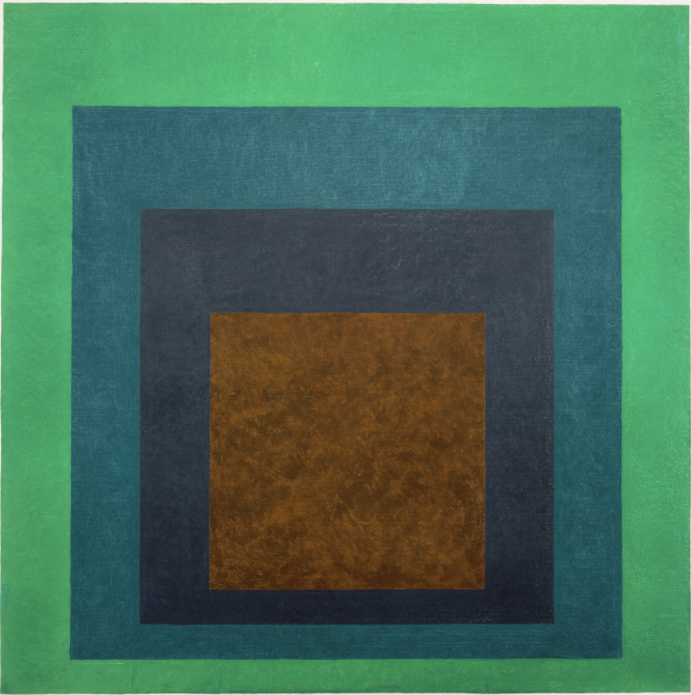JOSEF ALBERS: MODEL AND SCALE
Josef Albers, a German artist and educator, was renowned for his iconic sequencing of shapes, materials and space while re-ordering different materials through drawings, works on paper, prints and iterations. Through repeated experiments and research, Albers mastered the ability of communicating open colours and contrasting it with ground colours, which ultimately eliminates the underlying hue from each colour scheme. Through his interaction with colour and geometric expression, Albers steps away from an ordinary, dogmatic approach and in turn produces an exciting approach to creation.
Observation and tooling analysis:
This lithograph by Albers demonstrates his understanding of conjoining the space between repeated shapes, through the limited yet equal dividing range. My overall impression of this work is that it's simplistic subjectivity offers a complex view on its recurring patterns, which are created through the different measures of thickness within the lines. Albers has repeated this shaped pattern in a diagonal direction, while also overlapping the sequences to cause dimension within its detail. This lithograph has been made through Albers' previously reproduced work through physical model making, and printed into a hand drawn image.
Visual and material analysis:
Within the model, the arrangement of lines and volumes within its composition are repeated to form a pattern, yet are also overlapped and layered over each other. I have highlighted this in my drawing as the lined patterns are seem to be overlapped at their chosen intersections. These intersections are the dominant elements in the drawing, and what gives the model more dimension. The circled pink points indicate the axonometric points, as the major intersections are what creates Albers innovative geometric placing. The importance of these axonometric points can be seen in my secondary drawing, where the negative spaces are shown without the lined detail. The line elements are what makes up the enclosing space, while the repeated corners created a zigzag edge around the model.
Sketches:




Lithograph 1:

Albers, J, 1942. Ascension from the series Graphic Tectonic, Reinhard Schumann. Lithograph. From https://www.moma.org/collection/works/65881?sov_referrer=artist&artist_id=97&page=1
Observation and tooling analysis:
This lithograph created by Albers is also made with previously reproduced work through physical model making, and printed into a hand drawn image. Similarly to the previous lithograph, the rectangular and lined shapes are repeated, yet they are not necessarily overlapped. My overall impression of this lithograph is that for the audience, it is easy to envision how the physical model would appear, as it holds a strong 3 dimensional element that can be seen as pushing forwards and backwards within each rectangular sequence. Albers perfects this by using the geometric technique of differing thicknesses in each line, as well as symmetrical spacing between each fourth section.
Visual and material analysis:
Within the model, the rectangular sections act as an opening, and a place where the audience divert their attention towards. The openings within the lined patterns also act as an opening, as it produces a model that does not have a completely connected composition. These axonometric points have been circled in pink, as they are similar to Albers attempt at at a diagonal 3dimensional effect. Although his lithograph is more detailed, I tried to interpret his detailing style and technique in a more simplified way. I have also sketched the negative points, to highlight how much the lined detailing impacts the composition of the lithograph.
Sketches:



Lithograph 2:

Albers, J, 1942. To Monte Alban from the series Graphic Tectonic, Reinhard Schumann. Lithograph. From https://www.moma.org/collection/works/65879?sov_referrer=artist&artist_id=97&page=1
Observation and tooling analysis:
This model by Albers is created through oil on a compressed board, and is a demonstration of his interaction with colour and geometric spacing. My overall impression of this model is that the relative colour scheme corresponds with the repeated square pattern, and enhances the symmetry within its spacing. This piece is unlike Albers usual models, as the shapes and patterns are not overlapping, however they encapsulate a shrinking perspective on repetitive patterning. Its simplistic use of colour replaces his overlapping technique, as although the colours portray an earthy organic scene, they are shown within each shape and stuck on top of each other.
Sketches:



Model 3:

Albers, J. 1963, Homage to the Square in Green Frame. The William S. Paley Collection. Oil on compressed board. From https://www.moma.org/collection/works/83359?sov_referrer=artist&artist_id=0&page=2
Albers use of colour within his work are within a colour scheme, as he works within tertiary, primary and secondary groups. His colourful series share a relationship between hues and colours, which is used as a tool of expression.

Colour wheel, showing the primary, secondary and tertiary colour groups and their relationship. https://www.flickr.com/photos/jasmic/476359521
Through paper iterations, I delved into Albers geometric techniques as he was known to teach his students with paper as it is lightweight and easy to manipulate. I experimented with how I could make the model stand up right and stabilised.
Iterations:



As I am working towards a fashion design degree, I was planning on using fabrics and a sewing machine to layer patterns and colours with different seaming techniques, however due to complications with my sewing machine a resorted to old newspapers and magazines to collage colour tones and insert lined patterns with a Stanley knife. For my final model I eliminated the newspaper aspect, and transformed the 2 dimensional paper cutouts to a standing model. The final model incorporates Albers geometric expression and colour scheming.
Practice:




Final model:



REFERENCE LIST
Kemp, M. (1997). Albers’s abstracts. (relationship between abstract paintings of Josef Albers and scientific theories). Nature, 390(6659).
Linton, D. (2012). The Sacred Modernist: Josef Albers as a Catholic Artist. Art and Christianity, (71).
Rhodes, D. (2012). Josef Albers: paintings, drawings, prints. The Brooklyn Rail.

